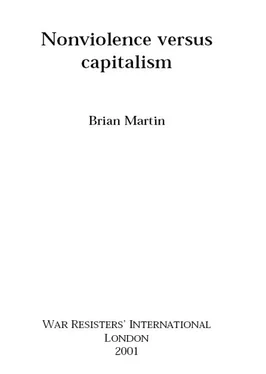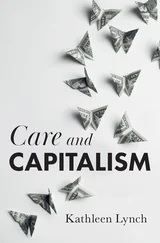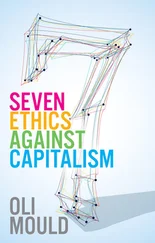There is another important reason why nonviolence planning is needed to tackle capitalism: the ways that exploitation and damage under capitalism are disguised. This is nothing new or peculiar to capitalism, since every system of exploitation and inequality is justified by some rationale, whether it is the divine right of kings or the naturalness of the caste system. Yet the process of obfuscation is less transparent with capitalism. The exploitation involved in trade — for example, selling bananas in exchange for computers — is not so immediately obvious as is the source of repression when police beat and torture dissidents. The mystifications involved in the commodity form were described insightfully by Marx in the mid 1800s, yet it remains a challenge to expose the exploitation involved.
Information — including records, computer programs, correspondence, and much else — plays an ever larger role in capitalist economies. This causes additional factors to come into play that make exposure of capitalist oppression more difficult. Governments use “disinformation” — intentional telling of lies and half-truths — to advance their interests. Corporations and governments use public relations to give their messages the right “spin,” both to boost favourable images and block damaging stories. Advertising fosters a mind-set in which it is natural to assume that commodities are the solution to problems, hindering critical thinking about the whole commodity system. Hollywood filmed entertainment creates attractive but deceptive images of what life can be like. The result is an information-rich environment that is immensely enticing. Contrary viewpoints, although sometimes censored, are often tolerated on the margins, giving the impression that there is a genuine marketplace of ideas.
This rich information environment provides new challenges for nonviolent activists. The traditional Gandhian philosophy of satyagraha involves seeking the truth through dialogue, with nonviolent action as a means of encouraging opponents to engage in the dialogue. That approach makes some sense when the facts of repression and oppression are reasonably obvious, where there is an obvious source of oppression and where there are opponents with whom activists can engage in dialogue, directly or via intermediaries. These conditions no longer apply. Much of the oppression in capitalism is built into the system of ownership and exchange: there are few obvious “opponents” who by their actions can change the system. Furthermore, the system for producing “unreality” has become so pervasive that straightforward dialogue seems ever more elusive. This is another reason why, for nonviolent action to be used effectively to transform capitalism, a deeper analysis is required, plus careful planning. A system built on a surfeit of information (with plenty of distortions and imbalances) requires a different sort of strategy than a system built primarily on censorship.
There is another reason why nonviolent action has not been seen as a strategy against capitalism: it has been mostly used as a method for promoting reform within capitalism. Strikes, boycotts, work-to-rule, rallies and many other methods have been used to improve workers’ pay and conditions, oppose harmful products and block damaging developments. These are all quite valuable, but are seldom seen as challenges to capitalism as a system. As a result, nonviolent action is not recognised as a potentially revolutionary strategy.
“Revolution,” namely a fundamental change in social relations, is of course the rhetoric of Marxism. “Reform” is seen as tepid and inadequate, even though a series of reforms may end up having a more lasting impact than a revolution that is quickly corrupted or reversed. Leninist strategy often relies on nonviolent action for early stages but on violence for “advanced” stages of overthrowing the ruling class. One result is that those who perceive themselves as revolutionaries seldom think of nonviolence as the primary means.
There are several ways to address this. One is to develop the model of nonviolent revolution, which has been espoused by Gandhi, Jayaprakash Narayan, Erik Dammann and others. [3] . Erik Dammann, Revolution in the Affluent Society (London: Heretic Books, 1984); Dave Dellinger, Revolutionary Nonviolence: Essays (Garden City, NY: Doubleday, 1971); George Lakey, Strategy for a Living Revolution (New York: Grossman, 1973); Brian Martin, Social Defence, Social Change (London: Freedom Press, 1993); Martin Oppenheimer, The Urban Guerilla (Chicago: Quadrangle, 1969); Geoffrey Ostergaard, Nonviolent Revolution in India (New Delhi: Gandhi Peace Foundation, 1985).
Another is to scrap the very image of revolution as too tainted by violent and masculine imagery, and to substitute an alternative, such as to think in terms of goals and methods of equality, justice, truth and participation. One challenge is that the vocabulary of “revolution” has been taken over by advertisers. [4] . The title of a new glossy magazine is Revolution: Business and Marketing in the Digital Economy. A billboard — an ad for Adobe — shows several men in suits with their neckties ablaze, with the web site address www.smashthestatusquo.com. Then there is the Apple Computer ad showing Gandhi and his spinning wheel, with the Apple slogan “Think different,” flying in the fact of the fact that Gandhi was a trenchant critic of both capitalism and much modern technology.
Any alternative vocabulary is similarly susceptible.
In any case, if nonviolent action is to become a strategy against capitalism, to replace it or transform it into something qualitatively different, then the strategy needs to go beyond reform. The key here is strategy. For nonviolence to be effective against capitalism, improved understanding is needed, both of capitalism and of nonviolence itself.
Social analysis and social problems
To undertake an effective campaign requires some level of investigation. For example, a campaign against genetically engineered crops needs information on environmental risks, likely impacts on farmers and organic alternatives, plus insight into government and corporate strategies and how they can be countered. Knowledge and insight are invaluable, especially in a field where advanced science and technology play such a major role.
The professionalisation of intellectual work, especially in universities and research laboratories, has led to incredible specialisation. This is most true of technical fields such as biochemistry and computer engineering. The only groups that can take advantage of most such research are those with large resources, especially governments and major corporations, which are able to hire researchers and set the agenda for much of the research. In contrast, protest groups have little money or capacity to hire researchers or to fund expensive investigations. With a budget even one tenth of that devoted to military research and development, enormous advances in nonviolent struggle could be made. [5] . Brian Martin, Technology for Nonviolent Struggle (London: War Resisters’ International, 2001).
Lacking the capacity to hire researchers or fund their own research, social movements rely heavily on investigations carried out by sympathisers, especially academics. There are many academics who study issues of interest to activists, but unfortunately most of them aim to communicate primarily to other academics. The academic system rewards scholars who publish in refereed journals, namely those relying on critical scrutiny of submissions by peers, which is a recipe for dealing only with what impresses scholars and not with what is beneficial to activists.
This has led to a way of thinking that affects even those scholars who are sympathetic to action. The basic approach is to get the theory right and then draw conclusions. The main orientation is to analysis and critique, with very little on alternatives or strategies. This sort of work can be quite valuable — some of it is truly inspiring — but it is not likely to be the foundation for participatory understanding.
Читать дальше

![Brian Jacques - Martin the Warrior [Redwall 6]](/books/128385/brian-jacques-martin-the-warrior-redwall-6-thumb.webp)










